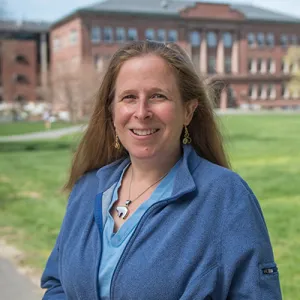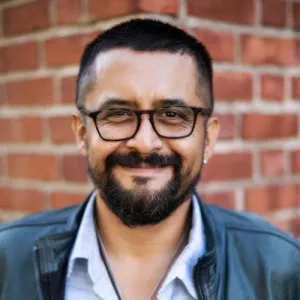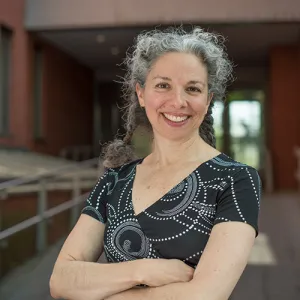Teaching with Conviction, Empathy, and Joy
Research & Inquiry
As a new semester gets underway, four Smith faculty members reflect on how they are teaching in uncertain times
Published September 11, 2025
For longtime Smith faculty member Katy Schneider, the start of a new semester is always unpredictable. “Every class is a living organism and I have to spend time taking the pulse,” says Schneider, who is a lecturer in art.
Still, the beginning of this academic year feels loaded with more than the usual question marks, given an unstable national political climate, the withdrawal of federal support for scientific research, the dismantling of diversity and equity initiatives, and cuts to study-abroad programs at colleges across the country.
For Crystal Fleming, professor of Africana studies, meeting the moment means “doubling and tripling down on doing my job at a time when doing my job is particularly challenging.”
On the positive side, “I love the courses I’m teaching,” she says, “and I feel lucky and excited to be shining a light on Black perspectives and experiences with regard to everything from feminism to spirituality to ideas about what constitutes reality.”
Laura A. Katz, Elsie Damon Simonds Professor of Biological Sciences, says it’s important to let students know that faculty also feel uncertain about fast-changing current events.
“I’ll put up a slide with a picture of the Earth spinning and just say, ‘I acknowledge the moment,’” Katz says. “On my syllabus, I invite students to let me know when there are things going on in their lives that are going to be distracting to them.”
For Javier Puente, taking a global view of his work helps him stay hopeful.
“I’m approaching my teaching as a Latin American person with a conviction that higher education has, and should continue to have, a role to play in battling authoritarianism,” says Puente, who is associate professor of Latin American and Latino/a studies. “I want my classrooms to be spaces in which we can foster all the necessary tools that our students need to participate: critical thinking, social engagement, and political dissent.”
Here’s what else the four educators had to say in the next in our series of conversations with Smith faculty about teaching in uncertain times.

Are you teaching differently this fall in response to the current historical/political moment?
Laura Katz: “I’m trying to bring a real sense of compassion and empathy to the start of the semester, given the many destabilizing aspects of the moment. I like to talk about the privilege and the opportunity of being a Smithie—being able to go into the classroom and put some of the other things to the side and really engage in the academic mission. I try to walk that line between acknowledging the moment, but also inviting people into this opportunity we have to sit together and talk about whatever subject it is we’re exploring.”
Katy Schneider: “I’m fortunate that the class I’m teaching this semester, Painting 1, is such a fun way to spend time with students. I always start off by asking them why they are taking this class versus, say, learning art from Instagram reels or YouTube. More than ever, it seems critical that we engage with people in a way that gives them some distance from world topics. The world’s going to enter, whether they realize it or not, but it is nice to be engaged in something that’s just about this very moment—what’s in front of your eyes.”
Crystal Fleming: “For my course, Black Magic: Africana Encounters with the Paranormal, we have a number of exciting guest speakers. I think that’s one change that’s less about a response to this moment, and more about bringing folks into the class and expanding students’ horizons. I’m also really energized about a course I teach called Intro to Black Women’s Studies where I’m bringing in more student-directed and event-based learning. I ask students to choose a Black feminist event within the Five Colleges and attend, reflect, and share about that, whether it’s by speaking, writing, or creating a podcast. Thinking about experiential learning as a way to have a more human pedagogy is something I’m spending a lot of energy on right now.”
Javier Puente: “I returned to the U.S. to teach in 2019 after four and a half years in Chile. Nearly every single moment of social transformation in the rest of the Americas in the distant or the more recent past has started with students. So, I have the conviction that students and colleges have to play that same role here in battling authoritarianism. Now, how to do that? That’s something I am figuring out in every classroom, in every course, in every semester. And I have brilliant colleagues to help me do that.”
How are you helping students at a time when immigrants, trans people, and other groups feel threatened and under scrutiny?
CF: I encounter students who feel very disempowered right now; who have difficulty conceiving of a livable future. I also have students who may themselves be doubling and tripling down on activism, standing up for human rights and against war, genocide, and inhumanity. To be able to create discussions or moments of reflection for students to learn about power and its relationship to knowledge production, to community building—on and beyond our campus–I see that as an ongoing part of my charge. One way I try to do that in the classroom is to share power with students. Last semester, I had students co-create the syllabi and when that is done effectively, I think that can be a really engaging way for students to learn more about what it means to set boundaries and think through things together. We have an opportunity right now to teach our students, and our colleagues who would like to do this work with us, about the histories of our disciplines and what it means to do the work of resistance.”
KS: “Number one on my list is to provide students with some ‘nutrition.’ I’m an artist and I feel like art is therapy. I really hope that students, while they’re taking my class or after, can relay to people who might sometimes shy away from the arts or think it’s not worth their time, that it really is worthwhile. It truly is helpful to get yourself in a state of flow, to provide yourself some joy. It’s like including an exercise regimen in your schedule or doing an intramural sport. Making art feels like a necessary vitamin.”
What impact have you felt from cuts in federal grants for scientific research?
LK: “There have been grant cutbacks and that’s all really bad. But as bad as the federal funding cuts are—and we should be on top of that—it’s so much less in scale than the trauma of being an undocumented student right now, a student with undocumented family members, a transgender student, or anyone in another of the many targeted groups.
That said, it’s a real privilege to be able to engage in both teaching and research with students. It might well be in a research lab where we’re enabling them to be their best selves. I think we should be talking more about the joy of doing this type of work. I’ve worked on a variety of research projects with over 200 students since I’ve been at Smith and roughly every year, I have a student publish a peer-reviewed paper with me—these are great privileges.”
How are you responding to the growing use of AI in higher education?

JP: “I’m trying something vintage: I’m going to use bluebooks for my exams. That may turn me into the most unpopular professor on campus, but I’m okay with that. I think I’ve read enough about the cognitive disorders that AI is producing in younger people of school age. And I think the conversation about AI is just too quickly turned toward, ‘How do we adapt? How do we incorporate? How do we bring it into the syllabus?’ It feels like we are relinquishing something before we fight against it for long enough.”
LK: “I have a really clear policy in my syllabus about not using AI in a generative way. Early on in the semester, I have students do some work that they are meant to do without AI, and then they do the same set of questions with AI so they can see how AI might be misleading them. When I do writing assignments, I offer students who may need it the option of using AI as a reviewing tool, since I think there could be some leveling of the playing field there. But they have to turn in both copies—the pre- and post-work. I think we could be doing more as a community to highlight earlier on the role of critical thinking and what it means to plagiarize and why these things are problematic.”
CF: “I think whether it’s the impact of AI or the impact of propaganda, the role of social media making reality seem fuzzy, I think one of the most important tools we have as educators is to empower students to learn about the process of learning and to think about different forms of literacy—media literacy, AI literacy.”
What would be most helpful to you as educators at this time?
CF: “In our current context, faculty require institutional support and support that is ongoing for antiracist and social justice pedagogy. It makes a difference when we know that there is commitment to providing space, providing resources, providing opportunities to engage with each other about the challenges we are experiencing. We need an institutional container for us to build capacity, build community, share what’s working and where we’re stuck, where we need support and what other campuses are doing.”

KS: “I’d like to see more workshops or forums on civil discourse, and how people can learn to speak to one another, to be curious, to ask questions and not to assume. I see a lot of assuming and a lot of fear about expressing opinions. I’m not just talking about a workshop for students—I’m talking about something for everyone.”
What are you doing to stay energized and hopeful?
CF: “It goes back to being really intentional about building community. For me, that can be around teaching but also often around research. I’m really excited about a project I’m working on with colleagues in chemistry and math and bringing our work together around Black art and Black science. I’m also going into my third year of studying Japanese language. Being a student during these times teaches me so much. Joy is a big part of that, and fun is a big part.”
JP: “I went back to Peru for two and a half months and I got my life battery reenergized–not just on a family basis, but also seeing other realities and being reminded that there is a universe beyond the confinements of the U.S. Also holding the conviction that we will prevail in one way or another. This is not the first time that society on a national scale or even a global scale has been subdued under authoritarianism. And somehow, universities are still there, students are still there, teaching is still needed and people continue to foster critical thinking. We have to hold that conviction dear. It’s a beacon of light for us.”

